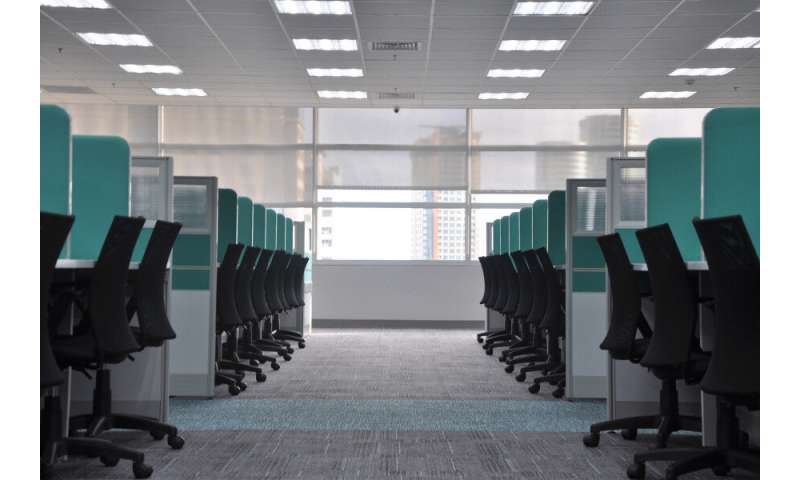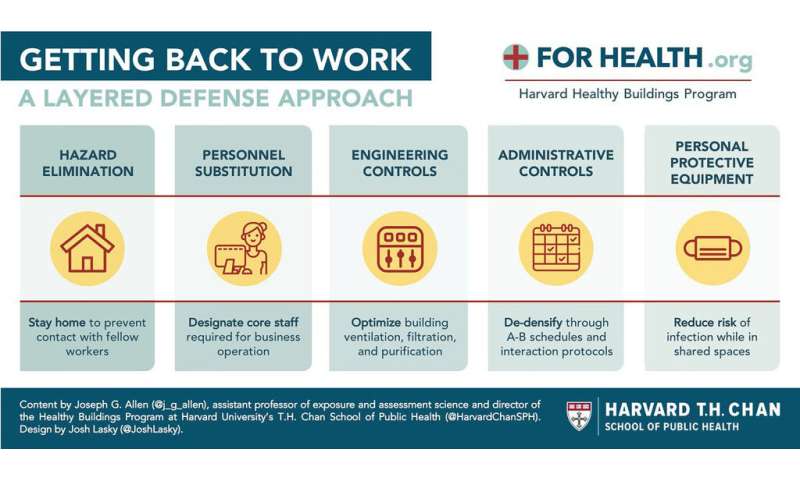A five-layered approach to safely reopening workplaces

A Harvard healthy-buildings expert has laid out a lower-cost, five-layered approach for employers and building managers as they consider how to safely reopen their establishments and get America back to work.
Joseph Allen, assistant professor of exposure, assessment science at Harvard T.H. Chan School of Public Health and director of the School's Healthy Buildings Program, said existing safety guidelines called the "hierarchy of controls," normally used to reduce risk in situations such as hazardous chemicals in the workplace, would be suitable for blocking exposure to COVID-19.
The system used by the Occupational Safety and Health Administration (OSHA) and the National Institute for Occupational Safety and Health (NIOSH) consists of five steps, with the use of personal protective equipment being the last, Allen said. They include:
- Hazard elimination, which means keeping employees home, a tactic that works for some, but not others, and won't lead to full economic recovery.
- Personnel substitution, in this case initially bringing back just those key employees who need to be physically present to get and keep the business running.
- Engineering controls, including healthy-building strategies such as increasing the flow of outside air, using portable air purifiers, and swapping existing filters in air circulating systems for ones that can capture smaller particles.
- Administrative controls, such as de-densify buildings by having portions of the workforce come in on alternate days or staggering shifts within a day. This might also include spreading workers out in space and limiting the use of conference rooms for large gatherings.
- Use of personal protective equipment (PPE), such as the now-familiar cloth face coverings, respirators, and other gear in common areas and situations where other controls don't achieve the required level of safety.
"I haven't yet come across an environment where putting in sensible controls isn't able to significantly reduce the risk," said Allen, who is deputy director of the NIOSH Education and Research Center on Worker Health and Safety.
There are additional actions that could be tailored to each workplace, Allen said. Employers could rearrange desks so workers would be offset instead of sitting directly across from each other; ensure hard surfaces are regularly disinfected; or position portable air purifiers near employees. Things like managing lines near elevators and ensuring PPE is used inside them would also be important.
Allen, who spoke to the media on a conference call Thursday, said the guidelines constitute a relatively low-cost roadmap for employers thinking about bringing people back to work. He cautioned against assuming any one action will provide complete protection, but said it's rather a matter of understanding and managing risks, not just putting a mask on everyone who walks through the door.
"There is no silver bullet here," Allen said. "You don't give someone a mask and say, "Our responsibilities are done.'"

Allen also cautioned that managing risks doesn't mean there will be no transmission.
"Everyone has to be really clear. There's no such thing as zero risk," Allen said.
And these guidelines don't mean businesses should reopen before it's safe to do so. Several Chan School epidemiologists and infectious disease experts have urged current social-distancing restrictions remain in place until case numbers have declined, health care system capacity is sufficient to handle a new increase in cases, and adequate testing is in place to detect any new surge in cases.
"I'm not talking about 'when,'" Allen said. "I'm talking about when they say it's clear, how you go about this safely."
There's a common misperception that strategies will necessarily be expensive, he said, but simple things like installing more efficient filters, increasing the supply of fresh air, and enhancing disinfection are well within the reach of most business owners.
"There are technology solutions that are being considered that are more expensive, require a big capital outlay, might take a couple of months to implement. But … I'm being cognizant we have to put in right now strategies that people can take and deploy in almost any situation," Allen said. "Broadly, these are strategies that people can put in and the costs are low or manageable."
Steps taken in the workplace, however, don't get everyone safely through their commutes. Those who drive or walk may have fewer concerns, but those who take public transportation face a tougher challenge, Allen said. For those taking car transport—taxis, Ubers, Lyfts—models have shown that simply opening a window three inches significantly decreases concentrations of airborne contaminants inside. For those whose commutes include time on subway trains and buses, however, he said more work still needs to be done.
"It's a vexing problem, everything about this pandemic is," Allen said. "I'm confident that we'll get there."
Provided by Harvard University
No comments:
Post a Comment